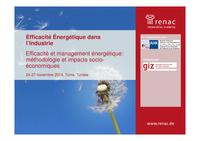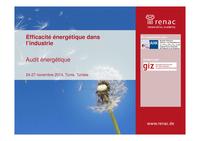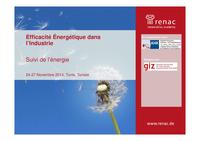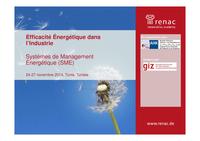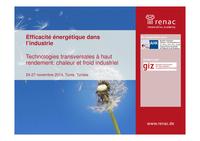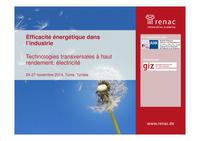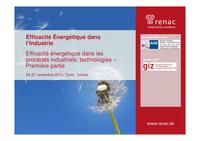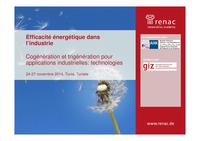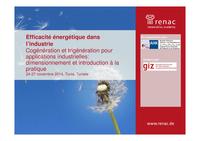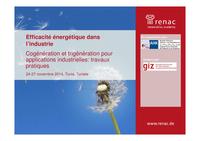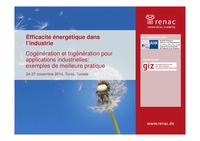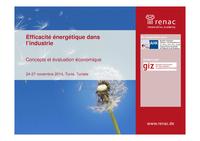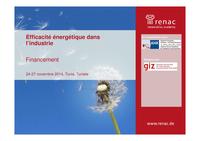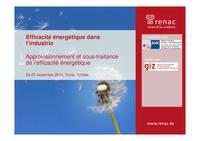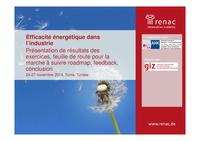Knowledge fuels change
For over a decade, Energypedia has shared free, reliable energy expertise with the world.
We’re now facing a serious funding gap.
Help keep this platform alive — your donation, big or small, truly matters!
Thank you for your support
Difference between revisions of "Energy Efficiency In Industry - Training Course"
***** (***** | *****) m |
***** (***** | *****) m |
||
| Line 1: | Line 1: | ||
| − | |||
= Overview = | = Overview = | ||
| Line 8: | Line 7: | ||
{| border="1" cellspacing="0" cellpadding="5" style="width:100%;" | {| border="1" cellspacing="0" cellpadding="5" style="width:100%;" | ||
|- | |- | ||
| − | | style="width: 204px;" | '''(1) Energy efficiency and management in industry: methodology and socio economic effects''' | + | | style="width: 204px;" | '''[[:file:Efficacité et Management Ènergétique - Méthodologie et Impacts Socioéconomiques.pdf|(1) Energy efficiency and management in industry: methodology and socio economic effects]]''' |
| + | [[File:Efficacité et Management Ènergétique - Méthodologie et Impacts Socioéconomiques.pdf|200px|border|Efficacité et Management Ènergétique - Méthodologie et Impacts Socioéconomiques]] | ||
| style="width: 532px;" | | | style="width: 532px;" | | ||
*Motivation to energy efficiency | *Motivation to energy efficiency | ||
| Line 17: | Line 17: | ||
|- | |- | ||
| − | | style="width: 204px;" | '''(2) Energy auditing''' | + | | style="width: 204px;" | '''[[:File:Audit_Ènergétique.pdf|(2) Energy auditing]]''' |
| + | [[File:Audit_Ènergétique.pdf|border|200px|Audit Ènergétique]] | ||
| style="width: 532px;" | | | style="width: 532px;" | | ||
*Energy audit: definition, audit typologies, Sankey diagram, benchmarking, technical instruments | *Energy audit: definition, audit typologies, Sankey diagram, benchmarking, technical instruments | ||
| Line 24: | Line 25: | ||
|- | |- | ||
| − | | style="width: 204px;" | '''(3) Energy monitoring''' | + | | style="width: 204px;" | '''[[:File:Suivi de l’énergie.pdf|(3) Energy monitoring]]''' |
| + | [[File:Suivi de l’énergie.pdf|200px|border|Suivi de l’énergie]] | ||
| style="width: 532px;" | | | style="width: 532px;" | | ||
*How to design a monitoring net | *How to design a monitoring net | ||
| Line 35: | Line 37: | ||
|- | |- | ||
| − | | style="width: 204px;" | '''(4) Energy Management Systems''' | + | | style="width: 204px;" | '''[[:File:Systèmes de Management Énergétique (SME).pdf|(4) Energy Management Systems]]''' |
| + | [[File:Systèmes de Management Énergétique (SME).pdf|border|200px|Systèmes de Management Énergétique (SME)]] | ||
| style="width: 532px;" | | | style="width: 532px;" | | ||
*The Energy Management Systems and the related international standards | *The Energy Management Systems and the related international standards | ||
| Line 46: | Line 49: | ||
|- | |- | ||
| style="width: 204px;" | '''(5-6) Energy efficient technologies: cross cutting technologies''' | | style="width: 204px;" | '''(5-6) Energy efficient technologies: cross cutting technologies''' | ||
| + | [[File:Technologies Transversales à Haut Rendement - Chaleur et Froid Industriel.pdf|200px|border|Technologies Transversales à Haut Rendement - Chaleur et Froid Industriel]] | ||
| + | [[File:Technologies_Transversales_à_Haut_Rendement_-_Èlectricité.pdf|border|200px|Technologies Transversales à Haut Rendement - Èlectricité]] | ||
| style="width: 532px;" | | | style="width: 532px;" | | ||
*Introduction | *Introduction | ||
| Line 59: | Line 64: | ||
|- | |- | ||
| style="width: 204px;" | '''(7-8) Energy efficient technologies: production processes''' | | style="width: 204px;" | '''(7-8) Energy efficient technologies: production processes''' | ||
| + | [[file:Efficacité Ènergétique dans les Procédés Industriels - Technologies – Première Partie.pdf|border|200px|Efficacité Ènergétique dans les Procédés Industriels - Technologies – Première Partie]] | ||
| + | [[file:Efficacité Ènergétique dans les Procédés Industriels - Technologies – Deuxième partie.pdf|200px|border|Efficacité Ènergétique dans les Procédés Industriels - Technologies – Deuxième partie]] | ||
| style="width: 532px;" | | | style="width: 532px;" | | ||
*Best Available Technologies: a systematic approach | *Best Available Technologies: a systematic approach | ||
| Line 68: | Line 75: | ||
|- | |- | ||
| − | | style="width: 204px;" | '''(9) Cogeneration and trigeneration for industrial applications: technologies''' | + | | style="width: 204px;" | '''[[[[file:Cogénération et Trigénération Pour Applications Industrielles - Technologies.pdf|(9) Cogeneration and trigeneration for industrial applications: technologies]]''' |
| + | [[file:Cogénération et Trigénération Pour Applications Industrielles - Technologies.pdf|border|200px|Cogénération et Trigénération Pour Applications Industrielles - Technologies]] | ||
| style="width: 532px;" | | | style="width: 532px;" | | ||
*Technologies: engines/micro-turbines, heat storage, extraction of heat and cold and the integration into existing systems, technical challenges and solutions | *Technologies: engines/micro-turbines, heat storage, extraction of heat and cold and the integration into existing systems, technical challenges and solutions | ||
| Line 74: | Line 82: | ||
|- | |- | ||
| − | | style="width: 204px;" | '''(10) Cogeneration and trigeneration for industrial applications: dimensioning''' | + | | style="width: 204px;" | '''[[file:Cogénération et Trigénération Pour Applications Industrielles - Dimensionnement et Introduction à la Pratique.pdf|(10) Cogeneration and trigeneration for industrial applications: dimensioning]]''' |
| + | [[file:Cogénération et Trigénération Pour Applications Industrielles - Dimensionnement et Introduction à la Pratique.pdf|200px|border|Cogénération et Trigénération Pour Applications Industrielles - Dimensionnement et Introduction à la Pratique]] | ||
| style="width: 532px;" | | | style="width: 532px;" | | ||
*Fuels and fuel related planning and safety aspects | *Fuels and fuel related planning and safety aspects | ||
| Line 81: | Line 90: | ||
|- | |- | ||
| − | | style="width: 204px;" | '''(11) Cogeneration and trigeneration for industrial applications: financing''' | + | | style="width: 204px;" | '''[[file:Cogénération et Trigénération Pour Applications Industrielles - Travaux Pratiques.pdf|(11) Cogeneration and trigeneration for industrial applications: financing]]''' |
| + | [[file:Cogénération et Trigénération Pour Applications Industrielles - Travaux Pratiques.pdf|200px|border|Cogénération et Trigénération Pour Applications Industrielles - Travaux Pratiques]] | ||
| style="width: 532px;" | | | style="width: 532px;" | | ||
*Planning support policy on distributed generation | *Planning support policy on distributed generation | ||
| Line 94: | Line 104: | ||
|- | |- | ||
| − | | style="width: 204px;" | '''(12) Cogeneration and trigeneration for industrial applications: exercises and examples''' | + | | style="width: 204px;" | '''[[:file:Cogénération et Trigénération Pour Applications Industrielles - Exemples de Meilleure Pratique.pdf|(12) Cogeneration and trigeneration for industrial applications: exercises and examples]]''' |
| + | [[file:Cogénération et Trigénération Pour Applications Industrielles - Exemples de Meilleure Pratique.pdf|200px|Cogénération et Trigénération Pour Applications Industrielles - Exemples de Meilleure Pratique]] | ||
| style="width: 532px;" | | | style="width: 532px;" | | ||
*Technical design – planning | *Technical design – planning | ||
| Line 105: | Line 116: | ||
|- | |- | ||
| style="width: 204px;" | '''(13-14) Economics and financing''' | | style="width: 204px;" | '''(13-14) Economics and financing''' | ||
| + | [[file:Concepts et Èvaluation Èconomique.pdf|200px|border|Concepts et Èvaluation Èconomique]] | ||
| + | [[File:Financement.pdf|200px|border|Financement]] | ||
| style="width: 532px;" | | | style="width: 532px;" | | ||
*Motives & Barriers | *Motives & Barriers | ||
| Line 115: | Line 128: | ||
|- | |- | ||
| − | | style="width: 204px;" | '''(15) Energy efficient procurement and contracting''' | + | | style="width: 204px;" | '''[[file:Approvisionnement et Sous-traitance de l’efficacité Ènergétique.pdf|(15) Energy efficient procurement and contracting]]''' |
| + | [[file:Approvisionnement et Sous-traitance de l’efficacité Ènergétique.pdf|200px|border|Approvisionnement et Sous-traitance de l’efficacité Ènergétique]] | ||
| style="width: 532px;" | | | style="width: 532px;" | | ||
*Energy Procurement | *Energy Procurement | ||
| Line 122: | Line 136: | ||
|- | |- | ||
| − | | style="width: 204px;" | '''(16) Energy efficiency in industrial process: financing instruments''' | + | | style="width: 204px;" | '''[[file:Présentation de Résultats des Exercices, Feuille de Route Pour la Marche à Suivre Roadmap, Feedback, Conclusion.pdf|(16) Energy efficiency in industrial process: financing instruments]]''' |
| + | [[file:Présentation de Résultats des Exercices, Feuille de Route Pour la Marche à Suivre Roadmap, Feedback, Conclusion.pdf|border|200px|Présentation de Résultats des Exercices, Feuille de Route Pour la Marche à Suivre Roadmap, Feedback, Conclusion]] | ||
| style="width: 532px;" | | | style="width: 532px;" | | ||
*Types of economic and financing instruments | *Types of economic and financing instruments | ||
| Line 239: | Line 254: | ||
{{Re-activate_Footer}} | {{Re-activate_Footer}} | ||
| + | [[Category:Training_Materials]] | ||
| + | [[Category:French]] | ||
[[Category:RE-ACTIVATE]] | [[Category:RE-ACTIVATE]] | ||
| − | |||
| − | |||
Revision as of 12:07, 7 August 2017
Overview
„Energy Efficiency in Industry“ in Tunis (24-27. Nov. 2014): Briefing für Herrn Erdle Das 4-tägige Training „Energieeffizienz in Industrie“ in Tunis wird von Renewables Academy (RENAC) AG in Kooperation mit der AHK Tunesien und mit Unterstützung der Deutschen Gesellschaft für Internationale Zusammenarbeit (GIZ) GmbH durchgeführt.
1. Inhalt/Programm:
| (1) Energy efficiency and management in industry: methodology and socio economic effects |
|
| (2) Energy auditing |
|
| (3) Energy monitoring |
|
| (4) Energy Management Systems |
|
| (5-6) Energy efficient technologies: cross cutting technologies |
|
| (7-8) Energy efficient technologies: production processes |
|
[[
|
|

|
|

|
|
| (12) Cogeneration and trigeneration for industrial applications: exercises and examples |
|
| (13-14) Economics and financing |
|

|
|

|
|
2. Dozenten:
| Dozent | Kontakt | Ankunft/Abfahrt | Hotel |
| Franck Daganaud |
Franck Daganaud 54 rue de la Folie-Régnault 7 5 011 Paris Tel: +33 (0) 1 43 48 68 71 Mobile: +33 (0) 6 73 88 47 74 franck.daganaud@wanadoo.fr |
Arrival in Tunis: 23. Nov. (Sunday), 15:25 p.m. Departure: 26. Nov. (Wednesday), 11:25 a.m. |
Hotel La Villa Bleue 68 rue Kennedy Sidi Bou Said - 2026 Tunisie International Tel. +33777283617 Tunisia Tel. +216 71 742 000 |
| Frank Schillig |
KWA EVIVA GMBH Vogelsanger Straße 250 D-50825 Köln T: +49 (0)221 78946911 F: +49 (0)221 78946949 M: +49 (0)173 2452938 E: f.schillig@eviva-energy.com |
Arrival in Tunis: 24. Nov. (Monday), 15:35 p.m. Departure: 28. Nov. (Friday), 09:20 a.m. |
Hotel Dar Fatma 1 Rue Sidi Bou Taraa, 2026 Sidi Bou Saïd M: 00216 25 246888 T: 00216 71 981284 |
3. Ansprechpartner beim Kooperationspartner AHK Tunesien:
| Name | Kontakt |
|
Mrs. Donia Medini Projektreferentin HR / Chargée de projets RH |
AHK Tunesien / AHK Tunisie Immeuble Le Dôme - Rue du Lac Léman Tel: 00216 71 965 280 Mob : 00216 28 665 999 Fax: 00216 70 014 179 Email : d.medini@ahktunis.org
|
Weitere Kontaktpersonen:
| Name | Kontakt |
|
Mrs. Oula Tarssim Projektmanagerin HR / Chef de Projet Ressources Humaines |
Tel: 00216 71 965 280 Mob: 00216 28 665 999 Email:o.tarssim@ahktunis.org |
|
Dr. Khaled Ben Yahia Abteilungsleiter HR Services / Directeur service Ressources Humaines |
Tel: 00216 71 965 280 Email:k.benyahia@ahktunis.org |
Reference
|
This article is part of the RE-ACTIVATE project. RE-ACTIVATE “Promoting Employment through Renewable Energy and Energy Efficiency in the MENA Region” is implemented by the Deutsche Gesellschaft für Internationale Zusammenarbeit (GIZ) GmbH on behalf of the German Ministry for Economic Cooperation and Development (BMZ). |

